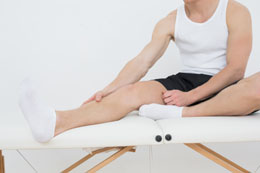Although most of us must have experienced groin and leg pain at some point in our life, majority of us are usually unaware of its causes. The forthcoming article sheds light on some of the probable causes in men and women.

Research shows that the pain experienced in the groin and leg region is one of the most common reasons for Americans to visit their physicians. Groin, back, and leg pain can either be experienced together or separately and usually have common reasons for their occurrence, like strain, overuse, and other physical injuries. The groin muscles usually include five adductor muscles, namely: the pectineus, adductor brevis, and adductor longus (called short adductors which are present from the pelvis to the thigh bone), the gracilis and adductor magnus (long adductors which span from the pelvis till the knee).
These muscles are present in the upper thigh region, and they pull the legs together upon contraction. The adductors are attached from the pelvis to the femur (thigh bone), and they help stabilize the hip joint. Hence, an inflammation or injury of these muscles can cause groin pain in the left or right side. A person may experience pain in the groin while walking or even while resting, and in extreme cases, the pain can be so severe that he/she may not be able to perform a simple task like lifting a pencil from the ground.
Causes of Leg and Groin Pain
➜ Groin Strain
A groin strain is a tear or rupture to any one of the adductor muscles due to an abrupt or rapid movement of the leg while running, changing direction, or moving against resistance (for example, kicking a ball). Repetitive overuse of the groin muscles may cause adductor tendinopathy, resulting in pain in the groin and leg areas.
➜ Hernia
Hernia is another common cause, which occurs when a part of the internal tissue (fat, muscle, intestines, etc.) bulges or protrudes through the overlying abdominal wall due to weakness in that area.
➜ Sciatica
Sciatica is an acute spasmodic leg pain that radiates from the back into the buttock region and then moves down into the back of the leg. Being a common cause for lower back, leg, and groin pain, it occurs when excessive pressure is put on the sciatic nerve that runs down the leg.
➜ Injury
An acute groin or leg injury due to a direct blow, stabbing injury, an accident, a fall, or a leg turned in an abnormal position can be a prime cause. Excessive stress on an injured area, by overdoing an activity, can eventually lead to muscle strain or tear, which may cause swelling and pain.
➜ Osteitis Pubis
Commonly misunderstood as muscle strain, osteitis pubis is an inflammation of the pubic bone that may cause pain around the groin and leg areas while performing any physical activity.
➜ Round Ligament
Round ligament is a common cause for groin and leg pain during pregnancy and is experienced by most of the women. During pregnancy, the thick ligaments that hold the uterus, called round ligaments, become longer and thinner as the uterus increases in size and weight. This may irritate the nearby nerve fibers, which results in pain in the groin and adjacent areas.
➜ Other Factors
Kidney stones, tumors, and inflamed or pinched nerves can be some of the other reasons.
Treatment Options
The treatment for this ailment mainly depends upon its underlying cause. If the pain is due to a muscle pull or strain, RICE treatment (rest, ice, compression, and elevation) provides immediate relief from the pain and swelling. There are many over-the-counter anti-inflammatory medications or painkillers available that can help reduce the pain and inflammation. Pain due to an injury can be cured through physical therapy or some strengthening or low-intensity exercises that will not only subside the pain but also prevent re-injury.
Mild to moderate pain in the groin and leg region usually does not warrant immediate medical attention and can be cured by taking self care at home. However, if the swelling and pain is severe to the extent that the person is not able to walk or perform routine activities, then seek immediate medical attention to prevent long-term damage.
Disclaimer: This Buzzle article is for informative purposes only and should not be used as a replacement for expert medical advice.


 Research shows that the pain experienced in the groin and leg region is one of the most common reasons for Americans to visit their physicians. Groin, back, and leg pain can either be experienced together or separately and usually have common reasons for their occurrence, like strain, overuse, and other physical injuries. The groin muscles usually include five adductor muscles, namely: the pectineus, adductor brevis, and adductor longus (called short adductors which are present from the pelvis to the thigh bone), the gracilis and adductor magnus (long adductors which span from the pelvis till the knee).
Research shows that the pain experienced in the groin and leg region is one of the most common reasons for Americans to visit their physicians. Groin, back, and leg pain can either be experienced together or separately and usually have common reasons for their occurrence, like strain, overuse, and other physical injuries. The groin muscles usually include five adductor muscles, namely: the pectineus, adductor brevis, and adductor longus (called short adductors which are present from the pelvis to the thigh bone), the gracilis and adductor magnus (long adductors which span from the pelvis till the knee).